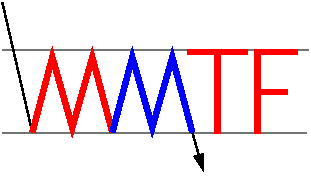NEW: In early 2009 a new method of observing with the MMTF was tested and found to drastically reduce the uncertainty in plate spacing and thus cut nightly overhead costs by up to 1-2 hours! By forcing IMACS (and thus the MMTF) to remain at a roughly constant gravity angle, the etalon will remain parallelized throughout the entire night, eliminating the need for costly re-parallelization and reducing the drift in the wavelength-spacing solution. Be sure to follow the directions below in order to take full advantage of this revolutionary technique.
MMTF observing is done using the standard IMACS data acquisition software along with a set of special built-in procedures. These include the ability to set the etalon fine X, Y, and Z values in the Hardhat GUI, as well as a set of programmable scripts that are run from the MMTF version of CamGUI. These scripts coordinate commands to the camera and the CS-100 for the following observing and calibration tasks:
- wavelength scanning;
- charge shuffling / frequency switching;
- determining the plate parallelism;
- taking data sausages for wavelength calibration.
Note that all access to etalon X, Y, and Z settings is through the IMACS software; the observer should not change the etalon settings with the CS-100 controller dials.
- Choice of observing mode.
The MMTF is intended to be operated in one of three modes:
- Staring mode. In staring mode, the etalon gap is fixed and the result is a narrow-band image in a single wavelength at each point in the field. However, the wavelength varies slowly across the field of view.
- Wavelength scanning mode. In scanning mode, an image is taken at a series of different etalon spacings. The result is a low-resolution spectrum at each position.
- Charge shuffling + frequency switching mode. See this section for a description of the charge shuffling and frequency switching mode. If you intend on using the charge shuffling mode, you should contact Sylvain Veilleux for planning assistance.
- Choice of Zcoarse. The Zcoarse, or coarse plate spacing, choice is a balance between the size of the monochromatic spot and the signal-to-sky contrast. Larger values of Zcoarse yield somewhat smaller monochromatic spot sizes. However, they also have smaller bandpasses, which means that the amount of sky emission transmitted is lower, thus increasing the signal-to-noise ratio.
- Choice of wavelength and filters. The available filters are listed in this table. The observer is limited to the use of at most 2 filters in a single night because of calibration overheads.
For each filter to be used during the first night, the following steps should be taken. For each step, refer to the Calibrations section for more details. Be sure that these calibrations are all performed at a gravity angle of Θgrav ~ 0° (ΘNASW = -47.3°).
For each step, refer to the Calibrations section for more details.
- Acquire the first target, and ensure that the field of view is properly rotated (Θgrav ~ 0°).
- Capture a reference image of an emission-line ring, and compute and apply a correction to A and Zfine [procedure].
- Compute and set the etalon to the appropriate Zfine for the wavelength of interest using WCALC.
- Before each exposure, direct the telescope operator to
re-acquire your target coordinates, in order to rotate IMACS to
Θgrav ~ 0° (be sure that the rotation mode in your
target file is "GRV" and the offset is "-47"; see the following example). When doing a sequence of multiple
exposures, re-acquire before each one in order to maintain a roughly
constant gravity angle throughout the night. This will minimize errors
in your wavelength solution and drastically cut down on nightly
overheads by up to 1-2 hours. After reaquiring, the toslit command can be used to place the target at a specific x,y position on a given chip.
- Take a reference ring regularly to check for drift in A (wavelength zero-point) and the line profile (parallelism) (procedure). This should be done every ~30 minutes while the temperature is changing dramatically at the start of the night, or every hour when the temperature is stable. If the line profile has degraded in quality (less narrow and/or less symmetric), you may have to recompute the parallelism (procedure). Use this reference ring to apply a correction to A and Zfine, using WCALC, to achieve the wavelength of interest.
- Exposure times should be no longer than 20-30 minutes to allow frequent checks for wavelength zero-point drift. Drift occurs more rapidly at the beginning of the night, due to more rapid temperature changes at this time. If you are doing on- and off-band imaging, be sure to do the on-band immediately after checking for wavelength drift while the wavelength solution is valid. The exact wavelength of the off-band image is less important and, thus, should always be done second.
- For exposures where it is important to achieve a continuous image uninterrupted by features or chip gaps, dither by 30 arcseconds or more in each direction. Dithering is important for IMACS imaging in order to bridge the inter-chip gaps, which are ~50 pixels, or 10 arcseconds, on average. The MMTF also introduces a set of reflections of the chip edges (of relative intensity a few percent) which are not corrected by the flatfields. These reflections contaminate ~100 rows and/or columns of each chip. Dithering over 5' scales is required for observations of extended sources or fields in charge-shuffle mode.
- Get dome flats at each wavelength that you observed during
the night [procedure].
(Can also be done in the afternoon prior to observing) - Get a series of biases (0-second exposures).

